Difference between iptables default policy to `DROP` and inserting a seperate policy in input chain to DROP all connections
If you have a default DROP INPUT policy, even the response packets from your outgoint connections will get dropped.
To accept those, add this input rule:
iptables -I INPUT 1 -m conntrack --ctstate ESTABLISHED,RELATED -j ACCEPT
As for your last question, in your c and d example (assuming empty rules before those commands) you are setting a first rule drop everything and a second rule that would accept traffic from a certain network. IPTABLES grabs a match as soon as it can, so the first rule always matches (no condition set) so every rule after that won't execute. Exceptions to a rule must be defined before the rule.
In the first example -P INPUT DROP, you are setting a last rule that will catch whatever was not matched before, so any exception added will be executed before that default rule (-P).
-I inserts into a certain position (for example, in my previous command, I am setting the ESTABLISHED,RELATED rule to be the first so it matches no matter what you set after that.
-A appends to the rule list, so if will be matched just before the default.
If you want to achieve the same as the first example with explicit rules (like c and d), you should exchange possitions of those.
Related videos on Youtube
dig_123
Updated on September 18, 2022Comments
-
dig_123 over 1 year
I'm trying to DROP all incoming connections to my server, except from particular networks. At the same time I want to keep all outgoing connections from my server to external network (any network over any protocol) open. It is working by making below two changes in INPUT chain:
Note: the testing was done with 3 servers (VMs) with IPs on 192.168.0.0/24 network, and all rules defined on server3 (IP: 192.168.0.3)
a. iptables -P INPUT DROP b. iptables -A INPUT -s 192.168.0.0/24 -j ACCEPT [root@server3 ~]# iptables -nvL Chain INPUT (policy DROP 124 packets, 22308 bytes) pkts bytes target prot opt in out source destination 265 34603 ACCEPT all -- * * 192.168.0.0/24 0.0.0.0/0 Chain FORWARD (policy DROP 0 packets, 0 bytes) pkts bytes target prot opt in out source destination Chain OUTPUT (policy ACCEPT 433 packets, 34693 bytes) pkts bytes target prot opt in out source destinationHowever, my first question:
- When I defined the first rule above (changing the default policy for INPUT chain), it stopped all outgoing connections(ssh , ping) from my server(IP: 192.168.0.3) as well. Why is this happening, if my default OUTPUT chain policy is still accept, and I don't have any rules defined under OUTPUT chain?
I wanted to achieve same thing by not changing the default policy for INPUT chain, like this:
c. iptables -I INPUT -j DROP d. iptables -A INPUT -s 192.168.0.0/24 -j ACCEPTBut it still blocks all incoming/outgoing connections to/from my server3. This brings me to my second question:
- How are the rules
c.anda.working differently ? Kindly help in understanding, as I'm new to linux firewalls.
-
dig_123 over 9 yearsthanks so much for the elaborate explanation. Now the importance of the
orderof the rules in each CHAIN is more clear. One more query relating to therulethat you suggested. Will it behave same as:iptables -I INPUT 1 -m state --state ESTABLISHED,RELATED -j ACCEPT? -
NuTTyX over 9 yearsIt's the same.
Stateis "older" and it seems thatconntrackwill be the standard on newer kernels. See serverfault.com/questions/358996/… for more detailed explanation. -
Infinity over 4 years@NuTTyX My default policy of input is drop, but there are rules that allows packets, same as the one you defined. More details of the iptable rules that I have added can be found here 0wned.it/2016/07/30/…. But problem is that I cannot access internet.
-
Vincent Gerris about 4 yearsSolved my Kubernetes routing problem by applying to the FORWARD chain, that by some process gets set to default DROP. -I FORWARD 1 -m conntrack --ctstate ESTABLISHED,RELATED -j ACCEPT


![IPTABLES [PART-1] : "UNDERSTANDING THE CONCEPT"](https://i.ytimg.com/vi/vbhr4csDeI4/hq720.jpg?sqp=-oaymwEcCNAFEJQDSFXyq4qpAw4IARUAAIhCGAFwAcABBg==&rs=AOn4CLBovKYd5heeT0eQFP4enqBJ_GCa1Q)

